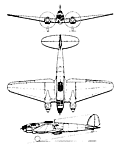 |
Heinkel He 1111935 |  |
| BOMBER | Virtual Aircraft Museum / Germany / Heinkel |
 |
Like a number of German aircraft which were designed and built in the 1930s, the He 111 was planned from the beginning for a dual-purpose role. The first was in a legitimate civil capacity, during which the engines and airframe would be developed to good standards of reliability, or modified as necessary to attain such high standards. The second role was for military usage by the Luftwaffe which, at the period when a number of Germany's most successful wartime aircraft were being designed and/or developed, was still a clandestine organisation. The prototype - an all-metal low-wing monoplane powered by two 447kW BMW VI in-line engines - flew for the first time on 24 February 1935. The wings were of semi-elliptical planform, fitted with hydraulically operated trailing-edge flaps, the tailwheel-type retractable landing gear also being hydraulically actuated. Very clean in appearance, the prototype (in bomber configuration) was able to accommodate an internal bomb load of 1,000kg, and was armed with three machine-guns in nose, dorsal and ventral positions. Flight testing proved that, like some British bomber aircraft of the period, its performance equalled or even bettered that of contemporary fighters. The second prototype was completed as a civil transport and was handed over to Luft-Hansa following the termination of early testing. Subsequently, this aircraft reverted to being used by the Luftwaffe for secret high-altitude reconnaissance missions. Many such missions were flown prior to the outbreak of World War II, both by military and civil aircraft, so that long before wartime operational missions were flown, the Luftwaffe had acquired very detailed documentation of a vast number of important targets. The fourth prototype was completed as a civil airliner with accommodation for ten passengers in two cabins. Named Dresden, it was delivered to Luft-Hansa on 10 January 1936 and given the full glare of press publicity. Six production airliners, He 111C named Breslau, Karlsruhe, Koln, Konigsberg, Leipzig, and Numberg, enured service from the summer of 1936. He 111B-1 production bombers began to enter Luftwaffe service in late 1936 and, like many German military aircraft of that period, were blooded first in the Spanish Civil War, gaining valuable experience. In the case of the He 111 it proved somewhat misleading: since its performance was superior to that of opposing fighter aircraft, it could operate unescorted. Similar tactics, when used against British Hurricanes and Spitfires, proved costly and from that time their deployment over Britain was mainly in the role of a night bomber. The mauling by British fighters meant that, as development progressed, He 111 became more heavily armed. Many had 20mm cannon and as many as seven machine-guns. Most extensively built version was the He 111H, with considerably more than 5,000 built before production ended in 1944. Power plant of this version comprised two Junkers Jumo engines, with power ranging from 752.6kW for the Jumo 221A to 1,323.5kW in the Jumo 213A-1 installed in the final production He 111H-23 paratroop carrier. Other roles fulfilled by this exceptional aircraft included torpedo-bomber, launch platform for Hs 293 glider bombs and V-1 flying-bombs, path finding using Y-Gerate, glider-tug, and with two aircraft "twinned" (He 111Z Zwilling, with a fifth engine at the new joining centre-section) operated as a tug for the Messerschmitt Me 321 Gigant (Giant) glider. A remarkable aircraft of long life - which speaks well for the excellence of its basic design - examples of Spanish-built aircraft (constructed by CASA post-war) remained in use for crew training into 1970.

|  COMPANY PROFILE | |||||||||||||||||||||||||||||||||||||||||||||||||||||||||
 |

|

